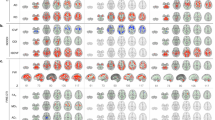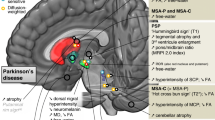Abstract
Objectives
To investigate the substantia nigra in patients with Parkinson’s disease three-dimensional magnetic resonance spectroscopic imaging with high spatial resolution at 3 Tesla was performed. Regional variations of spectroscopic data between the rostral and caudal regions of the substantia nigra as well as the midbrain tegmentum areas were evaluated in healthy controls and patients with Parkinson’s disease.
Methods
Nine patients with Parkinson’s disease and eight age- and gender-matched healthy controls were included in this study. Data were acquired by using three-dimensional magnetic resonance spectroscopic imaging measurements. The ratios between rostral and caudal voxels of the substantia nigra as well as the midbrain tegmentum areas were calculated for the main-metabolites N-acetyl aspartate, creatine, choline, and myo-inositol. Additionally, the metabolite/creatine ratios were calculated.
Results
In all subjects spectra of acceptable quality could be obtained with a nominal voxel size of 0.252 ml. The calculated rostral-to-caudal ratios of the metabolites as well as of the metabolite/creatine ratios showed with exception of choline/creatine ratio significant differences between healthy controls and patients with Parkinson’s disease.
Conclusions
The findings from this study indicate that regional variations in N-acetyl aspartate/creatine ratios in the regions of the substantia nigra may differentiate patients with Parkinson’s disease and healthy controls.





Similar content being viewed by others
References
Hughes AJ, Daniel SE, Kilford L, Lees AJ (1992) Accuracy of clinical diagnosis of idiopathic Parkinson’s disease: a clinico-pathological study of 100 cases. J Neurol Neurosurg Psychiatry 55:181–184
O’Keeffe GC, Michell AW, Barker RA (2009) Biomarkers in Huntington’s and Parkinson’s Disease. Ann NY Acad Sci 1180:97–110
Jankovic J, Rajput AH, McDermott MP, Perl DP (2000) The evolution of diagnosis in early Parkinson disease. Parkinson Study Group. Arch Neurol 57:369–372
Meara J, Bhowmick BK, Hobson P (1999) Accuracy of diagnosis in patients with presumed Parkinson’s disease. Age Ageing 28:99–102
Auer DP (2009) In vivo imaging markers of neurodegeneration of the substantia nigra. Exp Gerontol 44:4–9
Jansen JF, Kooi ME, Kessels AG, Nicolay K, Backes WH (2007) Reproducibility of quantitative cerebral T2 relaxometry, diffusion tensor imaging, and 1H magnetic resonance spectroscopy at 3.0 Tesla. Invest Radiol 42:327–337
Moffett JR, Ross B, Arun P, Madhavarao CN, Namboodiri AM (2007) N-Acetylaspartate in the CNS: from neurodiagnostics to neurobiology. Prog Neurobiol 81:89–131
Charles HC, Lazeyras F, Krishnan KR, Boyko OB, Patterson LJ, Doraiswamy PM, McDonald WM (1994) Proton spectroscopy of human brain: effects of age and sex. Prog Neuropsychopharmacol Biol Psychiatry 18:995–1004
Leary SM, Brex PA, MacManus DG, Parker GJ, Barker GJ, Miller DH, Thompson AJ (2000) A (1)H magnetic resonance spectroscopy study of aging in parietal white matter: implications for trials in multiple sclerosis. Magn Reson Imaging 18:455–459
Ferguson KJ, MacLullich AM, Marshall I, Deary IJ, Starr JM, Seckl JR, Wardlaw JM (2002) Magnetic resonance spectroscopy and cognitive function in healthy elderly men. Brain 125:2743–2749
Lazeyras F, Charles HC, Tupler LA, Erickson R, Boyko OB, Krishnan KR (1998) Metabolic brain mapping in Alzheimer’s disease using proton magnetic resonance spectroscopy. Psychiatry Res 82:95–106
Brand A, Richter-Landsberg C, Leibfritz D (1993) Multinuclear NMR studies on the energy metabolism of glial and neuronal cells. Dev Neurosci 15:289–298
Broom KA, Anthony DC, Lowe JP, Griffin JL, Scott H, Blamire AM, Styles P, Perry VH, Sibson NR (2007) MRI and MRS alterations in the preclinical phase of murine prion disease: association with neuropathological and behavioural changes. Neurobiol Dis 26:707–717
Mao H, Toufexis D, Wang X, Lacreuse A, Wu S (2007) Changes of metabolite profile in kainic acid induced hippocampal injury in rats measured by HRMAS NMR. Exp Brain Res 183:477–485
Massey LA, Yousry TA (2010) Anatomy of the substantia nigra and subthalamic nucleus on MR imaging. Neuroimaging Clin N Am 20:7–27
Hallgren B, Sourander P (1958) The effect of age on the non-haemin iron in the human brain. J Neurochem 3:41–51
Ordidge RJ, Gorell JM, Deniau JC, Knight RA, Helpern JA (1994) Assessment of relative brain iron concentrations using T2-weighted and T2*-weighted MRI at 3 Tesla. Magn Reson Med 32:335–341
Oz G, Terpstra M, Tkác I, Aia P, Lowary J, Tuite PJ, Gruetter R (2006) Proton MRS of the unilateral substantia nigra in the human brain at 4 tesla: detection of high GABA concentrations. Magn Reson Med 55:296–301
O’Neill J, Schuff N, Marks WJ Jr, Feiwell R, Aminoff MJ, Weiner MW (2002) Quantitative 1H magnetic resonance spectroscopy and MRI of Parkinson’s disease. Mov Disord 17:917–927
Choe BY, Park JW, Lee KS, Son BC, Kim MC, Kim BS, Suh TS, Lee HK, Shinn KS (1998) Neuronal laterality in Parkinson’s disease with unilateral symptom by in vivo 1H magnetic resonance spectroscopy. Invest Radiol 33:450–455
Hattingen E, Magerkurth J, Pilatus U, Mozer A, Seifried C, Steinmetz H, Zanella F, Hilker R (2009) Phosphorus and proton magnetic resonance spectroscopy demonstrates mitochondrial dysfunction in early and advanced Parkinson’s disease. Brain 132:3285–3297
Duijn JH, Matson GB, Maudsley AA, Weiner MW (1992) 3D phase encoding 1H spectroscopic imaging of human brain. Magn Reson Imaging 10:315–319
Ogg RJ, Kingsley PB, Taylor JS (1994) WET, a T1- and B1-insensitive water-suppression method for in vivo localized 1H NMR spectroscopy. J Magn Reson B 104:1–10
Mareci TH, Brooker HR (1991) Essential considerations for spectral localization using indirect gradient encoding of spatial information. J Magn Reson 92:229–246
Fayed N, Modrego PJ, Medrano J (2009) Comparative test-retest reliability of metabolite values assessed with magnetic resonance spectroscopy of the brain. The LCModel versus the manufacturer software. Neurol Res 31:472–477
Galazka-Friedman J, Friedman A, Bauminger ER (2009) Iron in the brain. Hyperfine Interact 189:31–37
Friedman A, Galazka-Friedman J, Koziorowski D (2009) Iron as a cause of Parkinson disease—a myth or a well established hypothesis? Parkinsonism Relat Suppl Disord 15:S212–S214
Träber F, Block W, Lamerichs R, Gieseke J, Schild HH (2004) 1H metabolite relaxation times at 3.0 tesla: measurements of T1 and T2 values in normal brain and determination of regional differences in transverse relaxation. J Magn Reson Imaging 19:537–545
Kirov II, Fleysher L, Fleysher R, Patil V, Liu S, Gonen O (2008) Age dependence of regional proton metabolites T2 relaxation times in the human brain at 3 T. Magn Reson Med 60:790–795
Author information
Authors and Affiliations
Corresponding author
Rights and permissions
About this article
Cite this article
Gröger, A., Chadzynski, G., Godau, J. et al. Three-dimensional magnetic resonance spectroscopic imaging in the substantia nigra of healthy controls and patients with Parkinson’s disease. Eur Radiol 21, 1962–1969 (2011). https://doi.org/10.1007/s00330-011-2123-5
Received:
Revised:
Accepted:
Published:
Issue Date:
DOI: https://doi.org/10.1007/s00330-011-2123-5




